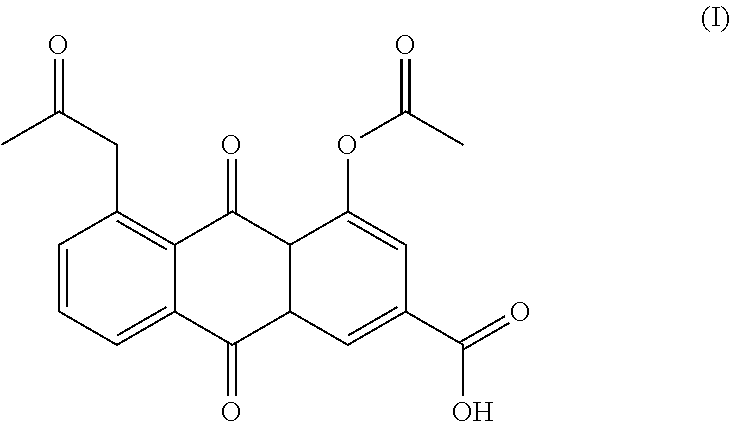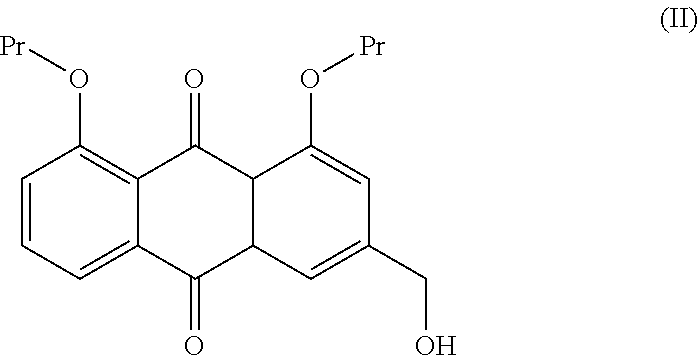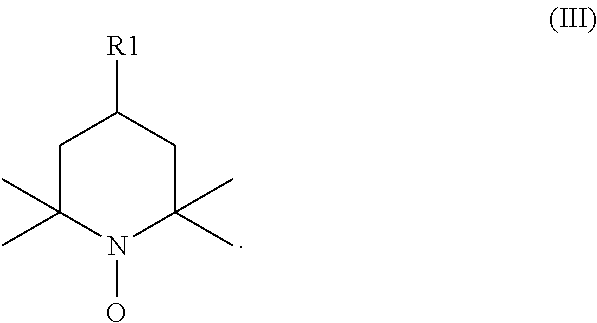Process for the preparation of diacerin
a diacerin and process technology, applied in the field of diacerin preparation, can solve the problems of high labor intensity, repeated purification, excessive volume of solvent needed for reaction, etc., and achieve the effect of high purity and high yield
- Summary
- Abstract
- Description
- Claims
- Application Information
AI Technical Summary
Benefits of technology
Problems solved by technology
Method used
Image
Examples
example 1
Preparation of 1,8-dibenzyloxy-3-(hydroxymethyl)anthraquinone (Dibenzyl Aloe-emodin)
[0037]483 g (3.5 moles) of potassium carbonate, 16 g (0.1 moles) of potassium iodide and 16 g (0.05 moles) of tetrabutylammonium bromide are added to a solution of 270 g (1 mole) of 1,8-dihydroxy-3-(hydroxymethyl)anthraquinone (aloe-emodin) in 3500 ml of DMF at 60° C.; the reaction mixture is heated at 80° C. for 1 h. It is cooled to 50° C. and 443 g (3.5 moles) of benzyl chloride are added dropwise in approximately one hour. At the end of the dripping, the reaction mixture is brought back to 80° C. and left at that temperature under stirring for 45-60 minutes. It is then cooled to 50° C. and 200 ml of methyl alcohol are added. It is cooled to 20-25° C. and the inorganic salts are removed by filtering. The organic solvent is distilled at 60-70° C. at reduced pressure and the residue is dissolved in 3200 ml of tetrahydrofuran at 60° C. Maintaining the temperature at 50-60° C., the organic phase is was...
example 2
Synthesis of 1,8-dibenzyloxyanthraquinone-3-carboxylic Acid (Dibenzylrhein)
[0040]10 g (0.06 moles) of radical 2,2,6,6-tetramethyl-1-piperidinyl-oxyl (TEMPO) and 1160 ml of an aqueous solution of 120 g (1 mole) of sodium dihydrogen phosphate and 180 g (1 mole) of disodium hydrogen phosphate are added in sequence to a suspension of 333 g (0.74 moles) of 1,8-dibenzyloxy-3-(hydroxymethyl)anthraquinone in 1660 ml of acetonitrile. The reaction mixture is heated to 35° C. and a solution of 167 g (1.5 moles) of sodium chlorite 80% in 513 ml of water is added dropwise in 40-50 minutes, maintaining the temperature around 35-40° C. 20 ml of aqueous sodium hypochlorite 10-12% are then dripped in and the reaction is heated to 60-65° C. for three hours. It is cooled to room temperature and 1400 ml of water are added. Phosphoric acid 85% is dripped in until reaching a pH of 2.8-3.2. The solid obtained is filtered and washed with water (350 ml×2). The damp product is dried at 50° C. at reduced pres...
example 3
Purification of 1,8-dibenzyloxyanthraquinone-3-carboxylic Acid (Dibenzylrhein)
[0041]337 g (0.72 moles) of crude 1,8-dibenzyloxyanthraquinone-3-carboxylic acid are dissolved in a solution of 134 ml of triethylamine in 900 ml of dimethylformamide DMF and 1800 ml of ethyl acetate, heating to 60° C. for 20-30 min. Any undissolved elements are removed by hot filtering and 2700 ml of water are added. The organic phase is separated and the aqueous phase is washed 6 times with 800 ml of ethyl acetate each time, maintaining the temperature at 60° C. The organic phase is cooled to room temperature and acidified with hydrochloric acid 33% until pH 2 is reached; the suspension thus obtained is cooled to 0-5° C. for approximately 1 hour. The product is filtered, washing it thoroughly with water (1200 ml) and then with 200 ml of acetonitrile. After drying at 50° C. at reduced pressure for 14-16 hours, 256 g of dibenzylrhein are obtained with a yield of 76%.
[0042]melting point : 250-251° C.
[0043]I...
PUM
| Property | Measurement | Unit |
|---|---|---|
| temperature | aaaaa | aaaaa |
| temperature | aaaaa | aaaaa |
| temperature | aaaaa | aaaaa |
Abstract
Description
Claims
Application Information
 Login to View More
Login to View More - R&D
- Intellectual Property
- Life Sciences
- Materials
- Tech Scout
- Unparalleled Data Quality
- Higher Quality Content
- 60% Fewer Hallucinations
Browse by: Latest US Patents, China's latest patents, Technical Efficacy Thesaurus, Application Domain, Technology Topic, Popular Technical Reports.
© 2025 PatSnap. All rights reserved.Legal|Privacy policy|Modern Slavery Act Transparency Statement|Sitemap|About US| Contact US: help@patsnap.com



